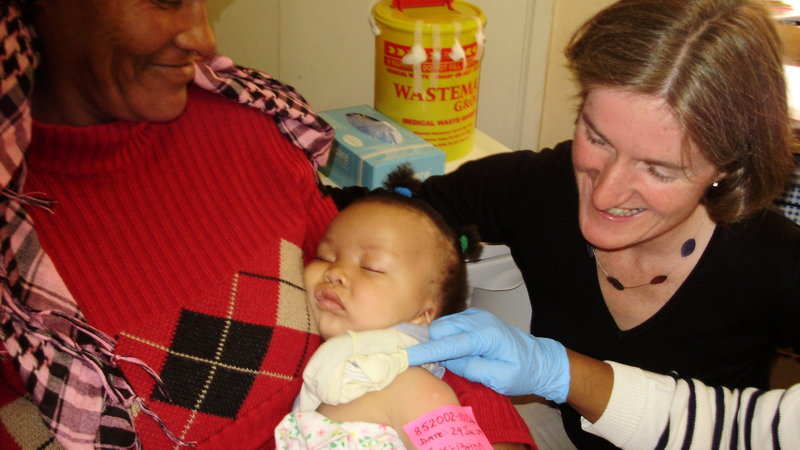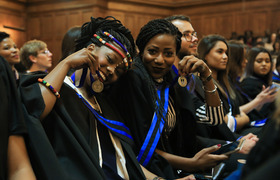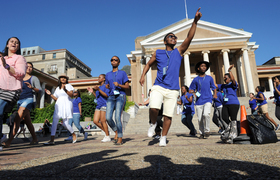TB vaccine candidate trail results disappoint
11 February 2013
Data published in The Lancet on 5 February from a Phase IIb clinical trial evaluating the safety and efficacy of MVA85A, a candidate vaccine for preventing TB in infants, show that a single dose is not sufficient to confer statistically significant protection against TB or infection in infants vaccinated at birth with BCG.
MVA85A is designed to boost immune responses already primed by the Bacille Calmette-Guérin (BCG) vaccine, the currently licenced and widely-used TB vaccine.
The Phase IIb study was sponsored by Aeras and conducted by UCT's South African Tuberculosis Vaccine Initiative (SATVI) in the Western Cape where nearly 2 800 HIV-negative infants were enrolled. The vaccine was originally developed and investigated by the University of Oxford.
There were 32 cases of TB disease in the infants that received BCG + MVA85A compared with 39 cases of disease among those receiving BCG + placebo. Non-significant vaccine efficacy was measured at 17.3% (95% CI -31.9% to 48.2%) at study completion. The vaccine candidate also did not provide statistically significant protection from infection with Mycobacterium tuberculosis, the bacterium that causes TB, which was a secondary efficacy endpoint.
"Although the results of this first efficacy trial of a new TB vaccine are not what we had hoped for, further analysis of the data should reveal a great deal about how the body's immune system protects against TB and what is necessary to develop an effective vaccine," said senior author Professor Helen McShane, a Wellcome Trust Senior Clinical Research Fellow at the University of Oxford.
"The results from this study should let us know far more about the type and level of immune response required, and that will boost future efforts to develop an effective TB vaccine by Oxford and other researchers throughout the world. The difficulty of this task is one reason why there has not been a new TB vaccine since BCG was developed more than 90 years ago, but one is still urgently needed, and I'm not about to give up now."
MVA85A is the first novel, preventive TB vaccine candidate since BCG to complete a Phase IIb safety and efficacy study.
The study was successful in that the vaccine was well-tolerated and there was no evidence of any harm to the trial participants. It also showed it is possible to conduct a large infant efficacy clinical trial in an area of high TB incidence with robust endpoints for detecting disease, something that is expected to greatly benefit future testing of TB vaccine candidates.
Funding for this clinical trial was provided by Aeras, a nonprofit biotech with a social mission to develop TB vaccines, The Wellcome Trust, and the Oxford-Emergent Tuberculosis Consortium (OETC), a joint venture between Oxford and Emergent BioSolutions.
It is anticipated that further analysis of the data and samples collected will be conducted for information that may be helpful for the development of new vaccine candidates. For example, blood samples will be used to identify markers that can predict whether a child will develop TB disease in the future. These biomarkers are termed "correlates of risk" and may substantially aid the development of new vaccines and contribute to different trial designs in the future.
"The results are not what we wanted to see, but I wouldn't say the trial was unsuccessful," director of SATVI Willem Hanekom said in an online article in Deutsche Welle. "We thought we had a strategy that might work, but in the end it did not. Now we have to find out why.
"It may be necessary to use a higher dose or even multiple doses - or perhaps the vaccine should be administered by inhalation, not by injection."
Hanekom said half a million South Africans develop the disease every year.
"Prevention by an effective vaccine would be the best way to get the epidemic under control. With this goal in mind, our group will continue to test multiple new vaccine candidates in the Worcester area. We are very grateful for the commitment of the local community in this effort."
 This work is licensed under a Creative Commons Attribution-NoDerivatives 4.0 International License.
This work is licensed under a Creative Commons Attribution-NoDerivatives 4.0 International License.
Please view the republishing articles page for more information.










